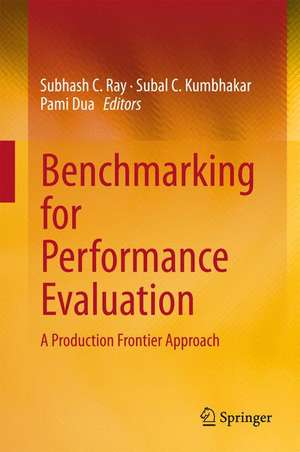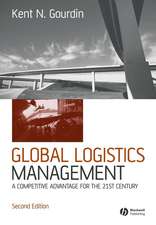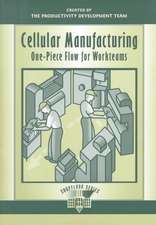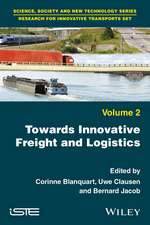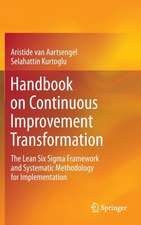Benchmarking for Performance Evaluation: A Production Frontier Approach
Editat de Subhash C. Ray, Subal C. Kumbhakar, Pami Duaen Limba Engleză Hardback – 7 apr 2015
Three of the papers in this volume provide a detailed and relatively easy to follow exposition of the underlying theory from neoclassical production economics and offer step-by-step instructions on the appropriate model to apply in different contexts and how to implement them. Of particular appeal are the instructions on (i) how to write the codes for different SFA models on STATA, (ii) how to write a VBA Macro for repetitive solution of the DEA problem for each production unit on Excel Solver, and (iii) how to write the codes for the Nonparametric Convex Frontier estimation. The three other papers in the volume are primarily theoretical and will be of interest to PhD students and researchers hoping to make methodological and conceptual contributions to the field of nonparametric efficiency analysis.
| Toate formatele și edițiile | Preț | Express |
|---|---|---|
| Paperback (1) | 640.37 lei 43-57 zile | |
| Springer India – 9 oct 2016 | 640.37 lei 43-57 zile | |
| Hardback (1) | 646.62 lei 43-57 zile | |
| Springer India – 7 apr 2015 | 646.62 lei 43-57 zile |
Preț: 646.62 lei
Preț vechi: 760.73 lei
-15% Nou
Puncte Express: 970
Preț estimativ în valută:
123.75€ • 128.72$ • 102.16£
123.75€ • 128.72$ • 102.16£
Carte tipărită la comandă
Livrare economică 14-28 aprilie
Preluare comenzi: 021 569.72.76
Specificații
ISBN-13: 9788132222521
ISBN-10: 8132222520
Pagini: 300
Ilustrații: XIV, 281 p. 73 illus.
Dimensiuni: 155 x 235 x 23 mm
Greutate: 0.59 kg
Ediția:2015
Editura: Springer India
Colecția Springer
Locul publicării:New Delhi, India
ISBN-10: 8132222520
Pagini: 300
Ilustrații: XIV, 281 p. 73 illus.
Dimensiuni: 155 x 235 x 23 mm
Greutate: 0.59 kg
Ediția:2015
Editura: Springer India
Colecția Springer
Locul publicării:New Delhi, India
Public țintă
ResearchCuprins
Introduction – Ray, Subhash; Kumbhakar, Subal & Dua, Pami.- Chapter 1. Estimation of Technical Inefficiency in Production Frontier Models Using Cross-Sectional Data by Kumbhakar, Subal C. & Wang, Hung-Jen.- Chapter 2. Data Envelopment Analysis for Performance Evaluation: A Child’s Guide by Ray, Subhash C. & Chen, Lei.- Chapter 3. An Introduction to CNLS and StoNED Methods for Efficiency Analysis: Economic Insights and Computational Aspects by Johnson, Andrew L. and Kuosmanen, Timo.- Chapter 4. Dynamic Efficiency Measurement by Førsund, Finn R.- Chapter 5. Efficiency Measures for Industrial Organization by Ten Raa, Thijs.- Chapter 6. Multiplicative and Additive Distance Functions: Efficiency Measures and Duality by Pastor, Jesus T. & Aparicio, Juan.
Notă biografică
Subhash C. Ray is Professor, Department of Economics, at the University of Connecticut, Storrs, CT, USA. He obtained his PhD in Economics from the University of California-Santa Barbara, USA. His subject areas are microeconomics and econometrics; and his areas of research interest are time series models and production analysis. Professor Ray is on the Editorial Board of many internal journals and has several published papers in acclaimed journals to his credit.
Subal C. Kumbhakar is the University Distinguished Professor in Economics at the Binghamton University, State University of New York, USA. He received his Ph.D. in economics from the University of Southern California in 1986. Professor Kumbhakar's main area of research is applied microeconomics with a focus on estimation of efficiency in production. He uses production, cost, and profit function approaches to estimate economic efficiency. Although his research in this area is based on micro data, hisspecialty is in the use of panel data. He has formulated a variety of panel data models to measure efficiency, which he has applied to U.S. railroads, airlines, Swedish agriculture, banking, manufacturing, electricity distribution and public administration, electric utilities in Texas, etc. He has also worked on models using cross-sectional data applications that include U.S. and Utah dairy farmers, Texas schools, and Indian agriculture. His current research is on modeling risk, dynamic efficiency, dynamic factor demand model, technical change, and regulation and total factor productivity. Professor Kumbhakar is currently a co-editor of Empirical Economics and serves on Editorial Boards of international journals.
Pami Dua is Professor and Head of Department of Economics, Delhi School of Economics, University of Delhi, India. She obtained her PhD from the London School of Economics, University of London, UK. She teaches econometrics, time series analysis, forecasting, and macroeconomics and her areas of research interest are business cycle analysis, macroeconomics, time series econometrics, and forecasting. Professor Dua has published many papers with acclaimed journals and is the Editor of the Indian Economic Review and Vice President of The Indian Econometric Society.
Subal C. Kumbhakar is the University Distinguished Professor in Economics at the Binghamton University, State University of New York, USA. He received his Ph.D. in economics from the University of Southern California in 1986. Professor Kumbhakar's main area of research is applied microeconomics with a focus on estimation of efficiency in production. He uses production, cost, and profit function approaches to estimate economic efficiency. Although his research in this area is based on micro data, hisspecialty is in the use of panel data. He has formulated a variety of panel data models to measure efficiency, which he has applied to U.S. railroads, airlines, Swedish agriculture, banking, manufacturing, electricity distribution and public administration, electric utilities in Texas, etc. He has also worked on models using cross-sectional data applications that include U.S. and Utah dairy farmers, Texas schools, and Indian agriculture. His current research is on modeling risk, dynamic efficiency, dynamic factor demand model, technical change, and regulation and total factor productivity. Professor Kumbhakar is currently a co-editor of Empirical Economics and serves on Editorial Boards of international journals.
Pami Dua is Professor and Head of Department of Economics, Delhi School of Economics, University of Delhi, India. She obtained her PhD from the London School of Economics, University of London, UK. She teaches econometrics, time series analysis, forecasting, and macroeconomics and her areas of research interest are business cycle analysis, macroeconomics, time series econometrics, and forecasting. Professor Dua has published many papers with acclaimed journals and is the Editor of the Indian Economic Review and Vice President of The Indian Econometric Society.
Textul de pe ultima copertă
This book provides a detailed introduction to the theoretical and methodological foundations of production efficiency analysis using benchmarking. Two of the more popular methods of efficiency evaluation are Stochastic Frontier Analysis (SFA) and Data Envelopment Analysis (DEA), both of which are based on the concept of a production possibility set and its frontier. Depending on the assumed objectives of the decision-making unit, a Production, Cost, or Profit Frontier is constructed from observed data on input and output quantities and prices. While SFA uses different maximum likelihood estimation techniques to estimate a parametric frontier, DEA relies on mathematical programming to create a nonparametric frontier. Yet another alternative is the Convex Nonparametric Frontier, which is based on the assumed convexity of the production possibility set and creates a piecewise linear frontier consisting of a number of tangent hyper planes.
Three of the papers in this volume provide a detailed and relatively easy to follow exposition of the underlying theory from neoclassical production economics and offer step-by-step instructions on the appropriate model to apply in different contexts and how to implement them. Of particular appeal are the instructions on (i) how to write the codes for different SFA models on STATA, (ii) how to write a VBA Macro for repetitive solution of the DEA problem for each production unit on Excel Solver, and (iii) how to write the codes for the Nonparametric Convex Frontier estimation. The three other papers in the volume are primarily theoretical and will be of interest to PhD students and researchers hoping to make methodological and conceptual contributions to the field of nonparametric efficiency analysis.
Three of the papers in this volume provide a detailed and relatively easy to follow exposition of the underlying theory from neoclassical production economics and offer step-by-step instructions on the appropriate model to apply in different contexts and how to implement them. Of particular appeal are the instructions on (i) how to write the codes for different SFA models on STATA, (ii) how to write a VBA Macro for repetitive solution of the DEA problem for each production unit on Excel Solver, and (iii) how to write the codes for the Nonparametric Convex Frontier estimation. The three other papers in the volume are primarily theoretical and will be of interest to PhD students and researchers hoping to make methodological and conceptual contributions to the field of nonparametric efficiency analysis.
Caracteristici
Rooted in the neoclassical economics of production, presents the analytical tools needed for efficiency analysis Brings together all key alternative methodologies – Stochastic Frontier Analysis, Data Envelopment Analysis, and Convex Nonparametric Efficiency Analysis – of the production frontier in a single volume Serves as a comprehensive reference work for researchers and practitioners evaluating the efficiency of resource utilization by business, government, and non-profit decision-makers Includes supplementary material: sn.pub/extras
